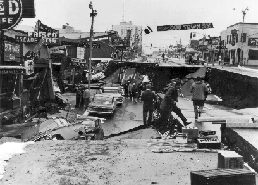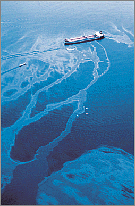|
ALASKA... SINCE STATEHOOD
On Good Friday, March 27, 1964, an earthquake with a magnitude of
9.2 rocked the
southwest coast of Alaska. Lasting 3 to 4 minutes, it left 131 people dead, and
the area looking like a war zone. Not only was this quake large enough and
devastating enough to be named the greatest North American earthquake, its 54 aftershocks continued to hit the area at magnitudes over 6.0 on the Richter
Scale. The quake occurred at 5:36 p.m. local time. M ost
Alaskans were home from work or on their way home. Children had been out of
school for several hours, and many college students had already headed home
for the holiday weekend. All of these simple factors would prove life-saving:
Although more than 100 people died during the ensuing disaster, the death toll
could have been far worse.
 Earthquake effects were heavy
in many towns, including Anchorage, Chitina, Glennallen, Homer, Hope, Kasilof,
Kenai, Kodiak, Moose Pass, Portage,
Seldovia, Seward, Sterling, Valdez, Wasilla, and Whittier. Though 75
miles from the epicenter, the city of Anchorage experienced the most damage
during the Good Friday disaster, according to U.S. Geological Survey (USGS)
records. In downtown Anchorage, about 30 blocks of stores, office buildings
and apartment buildings were damaged or destroyed. Businesses
were irreparably damaged; a new six-story apartment building completely collapsed. Most
schools in Anchorage were severely damaged. Local
tsunami waves triggered by this earthquake were extremely destructive in
Prince William Sound and other areas of Alaska. The height of the
largest local wave was recorded at about 230 feet, in Valdez Arm. In
Seward, a tidal wave rolled over an Alaska Railroad locomotive. A Pacific-wide tsunami was
generated which was destructive in Western Canada, Oregon, California and the
Hawaiian islands. Even tide gauges in Cuba and Puerto Rico recorded sea level
oscillations from that event. Combined, the earthquake and tsunami caused
about $311 million in property loss (in 1964 dollars). The
earthquake was the second most powerful in recorded history. The only other
quake to register a higher magnitude than the 1964 quake was the 9.5
earthquake in Chile in 1960. Earthquake effects were heavy
in many towns, including Anchorage, Chitina, Glennallen, Homer, Hope, Kasilof,
Kenai, Kodiak, Moose Pass, Portage,
Seldovia, Seward, Sterling, Valdez, Wasilla, and Whittier. Though 75
miles from the epicenter, the city of Anchorage experienced the most damage
during the Good Friday disaster, according to U.S. Geological Survey (USGS)
records. In downtown Anchorage, about 30 blocks of stores, office buildings
and apartment buildings were damaged or destroyed. Businesses
were irreparably damaged; a new six-story apartment building completely collapsed. Most
schools in Anchorage were severely damaged. Local
tsunami waves triggered by this earthquake were extremely destructive in
Prince William Sound and other areas of Alaska. The height of the
largest local wave was recorded at about 230 feet, in Valdez Arm. In
Seward, a tidal wave rolled over an Alaska Railroad locomotive. A Pacific-wide tsunami was
generated which was destructive in Western Canada, Oregon, California and the
Hawaiian islands. Even tide gauges in Cuba and Puerto Rico recorded sea level
oscillations from that event. Combined, the earthquake and tsunami caused
about $311 million in property loss (in 1964 dollars). The
earthquake was the second most powerful in recorded history. The only other
quake to register a higher magnitude than the 1964 quake was the 9.5
earthquake in Chile in 1960.
In 1968, massive oil deposits were discovered underneath Prudhoe Bay in the
Arctic Ocean. This sparked a new rush to Alaska and
provoked intense negotiations between a ravenous oil industry,
environmentalists and Native Alaskans with moral claims to land which now
promised to generate extraordinary wealth. A treaty was signed with the
indigenous population in 1971 and a 789 mile (1270km) pipeline to the warm-water
port of Valdez was constructed.
On July 28, 1977, the first barrel of crude oil came
down the trans-Alaska pipeline at Valdez. Salaries and prices in the state shot
up overnight. Alaska became the richest state in the USA.

Alaskans rode out their good fortune until the 1980s, when world oil prices
dropped and the biggest oil spill in U.S. history occurred. On Good Friday,
March 24, 1989 the supertanker Exxon Valdez ran aground on Bligh Reef in
Prince William Sound, Alaska, spilling an estimated 11 million gallons of crude
oil across
1,300
miles of coastline
- a catastrophic event that
contaminated 1,567 miles of shoreline and killed between 300,000 and 650,000
birds and marine animals. While the vast majority of the spill area
now appears to have recovered, pockets of crude oil remain in some locations,
and there is evidence that some damage is continuing.
Alaska provides one-eighth of the Nation's gold, nearly a
quarter of its oil production, and two-fifths of its
harvested fish. She possesses 10 of the 16 vital materials needed for the
Nation's security, and all of this has resulted in the National Treasury
collecting $3 for every $1 of Federal money that is spent in this rich and vital
State.
However, Alaska faces a significant fiscal crisis
raising fundamental questions about her future.
The exploitation of her natural resources, particularly oil, is a hot topic in
Alaska. The concerns of environmental groups, the desire for economic wealth and the
rights of the indigenous population generates heated debates as to how much of Alaska's pristine wilderness
should be developed. An increasing awareness that the Alaskan
wilderness is an outstanding natural resource all the more valuable if it is
left untouched may be the sentiment which saves the fabled frontier.
|